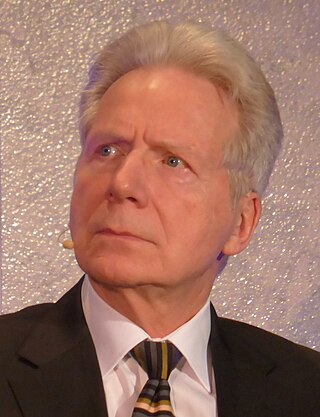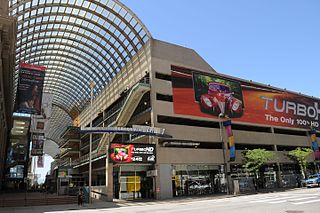Maryland is a U.S. state with a musical heritage that dates back to the Native Americans of the region and includes contributions to colonial era music, modern American popular and folk music. The music of Maryland includes a number of popular musicians, folk styles and a documented music history that dates to the colonial archives on music from Annapolis, an important source in research on colonial music. Famous modern musicians from Maryland range from jazz singer Billie Holiday to pop punk band Good Charlotte, and include a wide array of popular styles.

The John F. Kennedy Center for the Performing Arts is the United States National Cultural Center, located on the eastern bank of the Potomac River in Washington, D.C. It was named in 1964 as a memorial to assassinated President John F. Kennedy. Opened on September 8, 1971, the center hosts many different genres of performance art, such as theater, dance, orchestras, jazz, pop, psychedelic, and folk music.

The University of North Carolina School of the Arts (UNCSA) is a public art school in Winston-Salem, North Carolina. It grants a high school diploma, in addition to both undergraduate and graduate degrees. Founded in 1963 as the North Carolina School of the Arts by then-Governor Terry Sanford, it was the first public arts conservatory in the United States. The school owns and operates the Stevens Center in Downtown Winston-Salem and is accredited by the Southern Association of Colleges and Schools.

John Francis Mauceri is an American conductor, producer, educator and writer. Since making his professional conducting debut almost half a century ago, he has appeared with most of the world's great orchestras, guest-conducted at the premiere opera houses, produced and musically supervised Tony and Olivier Award-winning Broadway musicals, and served as university faculty and administrator. Through his varied career, he has taken the lead in the preservation and performance of many genres of music and supervised and conducted important premieres by composers as diverse as Debussy, Stockhausen, Korngold, Hindemith, Bernstein, Sibelius, Ives, Elfman and Shore. He is also a leading performer of music banned by the Third Reich and especially music of Hollywood's émigré composers.
The Boston Youth Symphony Orchestras (BYSO) is a youth orchestra based in Boston, Massachusetts under the artistic leadership of music director, Federico Cortese. Since 1958, BYSO has served thousands of young musicians from throughout New England with three full symphonic orchestras, two young string training orchestras, six chamber orchestras, a preparatory wind ensemble, a chamber music program and a nationally recognized instrument training program for underrepresented youth from inner-city communities called the Intensive Community Program (ICP). The 2017-2018 season marks the celebration of BYSO's 60th Anniversary. Each year, BYSO auditions approximately 850 students from throughout New England, ages 5–18, and accepts nearly 500 young musicians.

The University of Michigan School of Music, Theatre & Dance is an undergraduate and graduate institution for the performing arts in the United States. It is part of the University of Michigan at Ann Arbor. The school was founded in 1880 after Henry Simmons Frieze, founder and president of the Choral Union and the University Musical Society, urged leaders to include music among the school's offerings. The college was known then as the Ann Arbor School of Music. It was later incorporated into the University of Michigan with Calvin Brainerd Cady joining the faculty as the first instructor in music, after already being hired by Frieze to conduct the Choral Union.

The Krannert Center for the Performing Arts is an educational and performing arts complex located at 500 South Goodwin Avenue in Urbana, Illinois and on the campus of the University of Illinois Urbana-Champaign. Herman C. Krannert, an industrialist who founded Inland Container Corporation and an alumnus of the university, and his wife, Ellnora Krannert, made a gift of $16 million that led to the Krannert Center's construction. Max Abramovitz, the architect who designed the facility, was also an Illinois alumnus.

The Denver Performing Arts Complex in Denver, Colorado, is one of the largest performing arts centers in the United States. The DCPA is a four-block, 12-acre (49,000 m2) site containing ten performance spaces with over 10,000 seats connected by an 80-foot-tall (24 m) glass roof. It is home to a professional theater company and also hosts Broadway musical tours, contemporary dance and ballet, chorales, symphony orchestras, opera productions, and pop stars.

The National Centre for the Performing Arts (NCPA) is a multi-venue, multi-purpose cultural centre in Mumbai, India, which aims to promote and preserve India's heritage of music, dance, theatre, film, literature and photography. It also presents new and innovative work in the performing arts field.
The Henry and Leigh Bienen School of Music is the music and performance arts school of Northwestern University. It is located on Northwestern University's campus in Evanston, Illinois, United States.

Blumenthal Arts is a not-for-profit, multi-venue performing arts complex located in Charlotte, North Carolina. Opening in November 1992, Blumenthal owns and operates 4 theaters on 2 campuses in Uptown Charlotte.

Martin Marietta Center for the Performing Arts is the premier location for cultural arts and entertainment in Raleigh, North Carolina. The center consists of four unique venues, Raleigh Memorial Auditorium, Meymandi Concert Hall, A.J. Fletcher Opera Theater, and Kennedy Theatre.

The Blair School of Music, located in Nashville, Tennessee, provides a conservatory-caliber undergraduate education in music performance, composition, or integrated music studies within the context of a major research university, Vanderbilt University. Blair also provides music lessons, classes and ensembles to over 800 precollege and adult students each semester. Blair is the youngest and smallest of Vanderbilt's ten constituent schools and colleges.

Ransom Wilson is an American flutist, conductor, and educator.
The Governor's School for the Arts is a regional secondary arts school sponsored by the Virginia Department of Education and the public school divisions of Chesapeake, Franklin, Isle of Wight County, Norfolk, Portsmouth, Southampton County, Suffolk, and Virginia Beach. It is one of 19 Virginian academic-year Governor's Schools and provides intensive educational opportunities for identified gifted students in instrumental music, vocal music, dance, musical theatre, theatre & film, and visual arts. The school is housed in the historic Monroe Building in downtown Norfolk.

Presenting over sixty free shows annually on the Outer Banks of North Carolina, the North Carolina School of the Arts Summer Performance Festival, funded by the State of North Carolina, is produced, performed and directed by students, alumni, faculty and staff of the University of North Carolina School of the Arts (UNCSA). The family-friendly festival offers drama, music, dance and film performances for six consecutive weeks, late June to early August, at Roanoke Island Festival Park in Manteo, North Carolina. Since its inception in 1997, the summer festival has become an important cultural resource to residents and visitors of North Carolina and an enriching educational and training experience for emerging and professional artists of UNCSA. In 2007, the festival audience grew to a record attendance of over 11,000.

Megan LeCrone is an American ballet dancer and soloist with the New York City Ballet.
Leslie Spotz is an American pianist. She is Professor of piano at Tarleton State University.
Kenneth Frazelle is an American composer.

Tichina Vaughn is an American operatic dramatic mezzo-soprano active internationally in opera, concert halls and recitals. Starting at the Lindemann Young Artist Development Program at the Metropolitan Opera, her American career expanded into Europe, as member of the permanent ensembles of the Semperoper in Dresden and the Stuttgart Opera, where she was awarded the title of Kammersängerin in 2006. She has been a regular at the Arena di Verona and other major theaters worldwide, singing a wide repertoire span, with a "voluminous and dark mezzo" voice the dramatic Verdi roles such as Amneris in Aida, Eboli in Don Carlo, Azucena in Il trovatore and Ulrica in Un ballo in maschera, Wagner's Ortrud Lohengrin, Venus Tannhäuser, Fricka Die Walküre, Waltraute in Götterdämmerung and Strauss, Herodias in Salome and Klytemnestra in Elektra. According to Opernglas, Vaughn has a natural "great intensity" on stage, with an ample "voice, which flows richly, even in the low registers." The Neue Zürcher Zeitung describes her voice as an "enchanting satisfyingly rich mezzosoprano". Bernard Holland of The New York Times called hers "A voice of quality", which had "the presence and personality that might well fit the Met... a mezzo-soprano whose strong upper register gave hints of a dramatic soprano to come".













